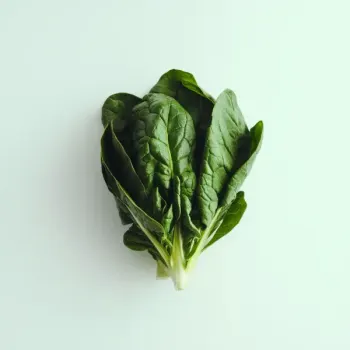"Spinach vs Kale" explores the differences between these leafy greens in cooking, including their taste, texture, and nutritional content, offering guidance on how to use them in salads, smoothies, and cooked dishes.

Spinach is a versatile leafy green with tender leaves and a slightly sweet flavor. It's commonly used in salads, soups, and sautéed dishes and is well-known for its nutritional benefits.

Kale is a hardy, cruciferous vegetable with a robust, earthy flavor and curly leaves. It's often used in smoothies, stews, and as a baked snack, and is celebrated for its high nutrient density.
Spinach and kale differ in taste, texture, and cooking times. Spinach has a mild, slightly sweet taste and delicate texture, wilting quickly when cooked. Kale offers a stronger, more bitter flavor with a tougher texture that requires longer cooking times. Spinach is typically grown in cooler climates, while kale is more cold-resistant and can grow in harsher conditions.

Your ultimate Recipe Box, Meal Planner, and Cooking Class all in one
Spinach is ideal for salads due to its soft texture. It pairs well with vinaigrettes and can be complemented with fruits like strawberries or nuts. Expect a refreshing and tender salad experience. Kale salads benefit from the leaf's sturdy texture, which holds up well with heavier dressings. Massaging kale with a bit of olive oil can soften the leaves. Expect a crunchy and hearty salad.
Spinach blends smoothly into smoothies without affecting the flavor profile too much, providing a nutrient boost with a clean taste. Kale adds a bold, earthy flavor to smoothies and may need to be blended longer due to its fibrous texture. It's perfect for a green smoothie packed with vitamins.
Spinach quickly wilts when cooked, making it a fast addition to dishes like omelets, pasta, and sautés. It adds a subtle flavor and color to the dish without overpowering other ingredients. Kale can stand up to longer cooking times, which makes it suitable for soups, stews, and braises. Its robust flavor complements hearty dishes and provides textural contrast.
Both spinach and kale are nutrient powerhouses, rich in vitamins A, C, and K, as well as minerals like iron and calcium.
| Nutrient | Kale ( per 100 grams ) | Spinach ( per 100 grams ) |
|---|---|---|
| Fat | 0.9g | 0.4g |
| Sodium | 38mg | 79mg |
| Calcium | 150mg | 99mg |
| Protein | 4.3g | 2.9g |
| Calories | 49 | 23 |
| Carbohydrates | 8.8g | 3.6g |
Both spinach and kale are considered superfoods, but kale has a slight edge in terms of nutrient content, particularly with higher levels of vitamins C and K.
Yes, you can substitute kale for spinach, but remember to adjust the cooking time as kale takes longer to become tender.
Kale can be eaten both raw and cooked, but massaging raw kale with dressing or oil can soften the leaves and make them easier to digest.
To reduce the bitterness of kale, you can massage it with salt or oil, blanch it in boiling water for a few minutes, or combine it with sweet or acidic ingredients.
Spinach is generally better for smoothies due to its mild flavor and softer texture, but kale can be used if you prefer a nutrient boost and don't mind the stronger taste.